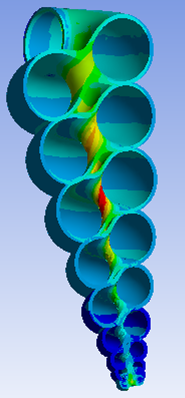 You don’t have to be a scientist to understand how much miraculous information we can glean from nature, and especially sea life, which has always been quite the enigma to man, as it’s just a little hard to get to. We do receive morsels of sea life though on a daily basis as shells and other flotsam wash up on the shore, with enthusiastic and greedy beachcombing hands ready to scoop them up and check them out.
You don’t have to be a scientist to understand how much miraculous information we can glean from nature, and especially sea life, which has always been quite the enigma to man, as it’s just a little hard to get to. We do receive morsels of sea life though on a daily basis as shells and other flotsam wash up on the shore, with enthusiastic and greedy beachcombing hands ready to scoop them up and check them out.
Our favorite shells are usually the ones that have come through the rolling waves unbroken. While fighting the elements on the way to arriving at the shoreline is a battle even the strongest shell often loses, engineering students at Rice University are interested in studying shells that offer significant evolutionary traits for survival due to their material. One shell in particular interests the team led by Chandra Sekhar Tiwary: your everyday mollusk.
 Tiwary is collecting shells and thinking about something that you probably are not as you get your feet wet and triumphantly scoop up a good find–he’s considering mechanical load. And with the help of 3D printing, these researchers are able to gain better insight into how we can replicate it. Carrying out the task of imitating these exoskeletons could very well be the catalyst for manufacturing better components for cars or even helping to make better materials for constructing entire buildings.
Tiwary is collecting shells and thinking about something that you probably are not as you get your feet wet and triumphantly scoop up a good find–he’s considering mechanical load. And with the help of 3D printing, these researchers are able to gain better insight into how we can replicate it. Carrying out the task of imitating these exoskeletons could very well be the catalyst for manufacturing better components for cars or even helping to make better materials for constructing entire buildings.
Often not even a shell you might save at the beach, the mollusk exhibits extraordinary information that is quite interesting to Tiwary, a graduate student from the Indian Institute of Science and a visiting student at Rice. Tiwary brought some beachcombing finds from India into the lab, and began working to study the material qualities of this common shell – which is common for a reason. Its soft insides but durable outer shell are most easily able to withstand the assault of both predators and the elements.
“Nature keeps on making things that look beautiful, but we don’t really pay attention to why the shapes are what they are,” said Tiwary.
One of the strong points of the mollusk, literally, is the way it’s able to handle stress at certain areas, thus protecting a living creature, should it have a current inhabitant. It’s as simple as studying shape and function. The hard part for engineers is emulating the unique durability of something that’s had eons to evolve. With 3D software and 3D printing, however, researchers have more latitude in experimenting with designs and materials that could offer a better way to imitate nature.
“With the help of 3D printing, these ideas can be extended to a larger reality,” said Tiwary.
With digital analysis and 3D printed models, the team was able to look at shell nacre (perhaps better known as mother-of-pearl) from two vantage points, by inspecting two different types of mollusks:
- Bivalves, which would be best known as the clam shell, exhibiting two different exoskeleton components which are hinged.
- Terebridae, which exhibit the screw shape found in many popular shells one finds on the beach. Stress is managed at the hinge point, and then the mechanical load travels from the center to the top, thus explaining the function of the shell’s odd shape.
 They used the 3D printer for replicating fan-shaped polymer shells, but they experimented with their natural shapes, printing some without ‘ribs.’ Researchers found that those types of shells showed cracks at the same areas in both the real ones and the 3D printed ones, rewarding the students with the fact that they did a very good job indeed of re-creating the shell material.
They used the 3D printer for replicating fan-shaped polymer shells, but they experimented with their natural shapes, printing some without ‘ribs.’ Researchers found that those types of shells showed cracks at the same areas in both the real ones and the 3D printed ones, rewarding the students with the fact that they did a very good job indeed of re-creating the shell material.
The findings were published in Science Advances, with co-authors Sharan Kishore, an undergraduate student; graduate student Suman Sarkar; and Professor Debiprasad Roy Mahapatra at the Indian Institute of Science.
Have you ever picked up a shell on the beach and considered the many facets involved in its shape, including mechanical load? Have you attempted to 3D print a shell design or similar structure or material? Share with us in the 3D Printing to Study Mechanical Load in Mollusks forum thread over at 3DPB.com.

Subscribe to Our Email Newsletter
Stay up-to-date on all the latest news from the 3D printing industry and receive information and offers from third party vendors.
You May Also Like
Printing Money Episode 17: Recent 3D Printing Deals, with Alex Kingsbury
Printing Money is back with Episode 17! Our host, NewCap Partners‘ Danny Piper, is joined by Alex Kingsbury for this episode, so you can prepare yourself for smart coverage laced...
Insights from Cantor Fitzgerald on AM’s Q1 2024 Landscape
A recent survey by Cantor Fitzgerald sheds light on the persistent challenges within the additive manufacturing (AM) industry in the first quarter of 2024. Based on responses from 38 industry...
3D Printing Financials: Xometry’s Scaling up and Strong Start to 2024
Xometry (Nasdaq: XMTR) kicked off 2024 with strong results, boosting its marketplace and technology to new heights. Both revenue and gross margin soared, fueled by an expanding global network of...
3D Printing Financials: Desktop Metal Targets Recovery Amid Net Losses and Revenue Downturn
Despite facing a decline in revenue and the persistent challenges of a tight economic climate, Desktop Metal (NYSE: DM) is making strides toward operational efficiency. The first quarter of 2024...
































